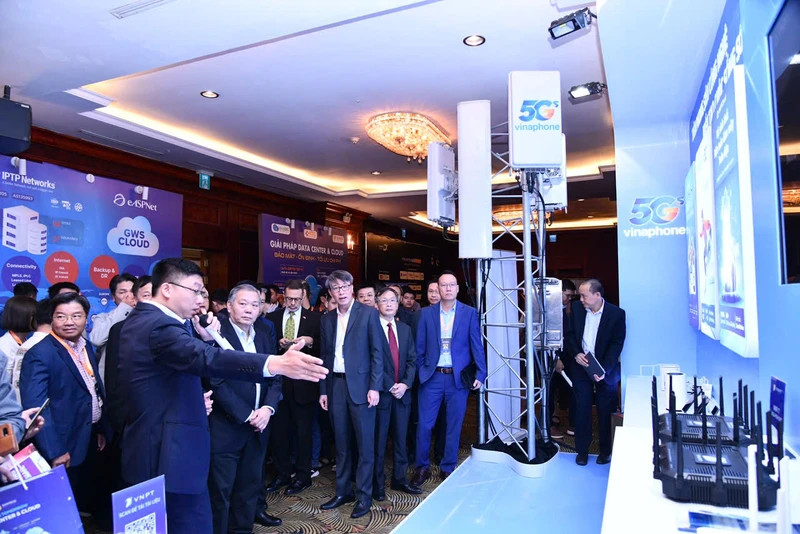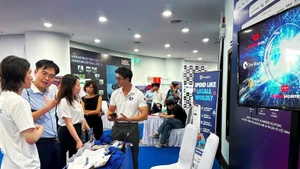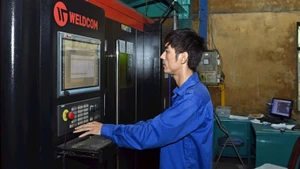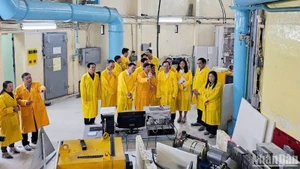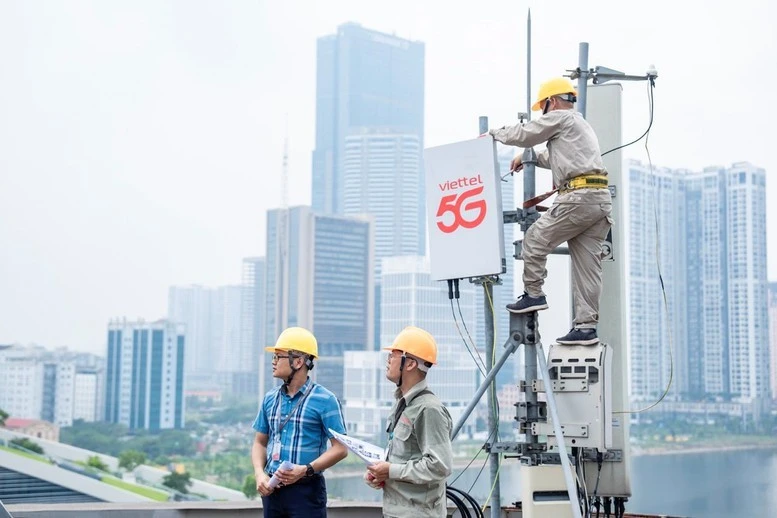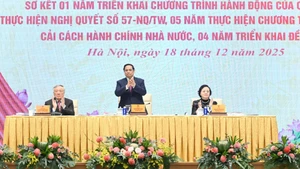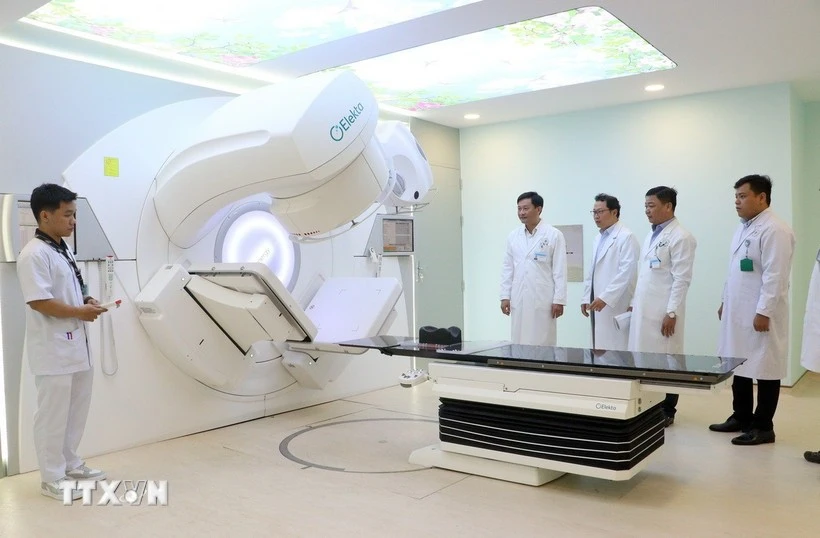According to experts, 5G and automation based on artificial intelligence (AI) are breakthrough technologies with great potential to revolutionise the manufacturing industry. Effective application of these two technologies will help businesses improve operational efficiency, increase productivity, reduce costs and increase competitiveness in the global market.
Opportunities and challenges intertwine
“A survey of a car factory in Spain applying 5G and new technologies to production and business activities showed that the operating costs of this enterprise were reduced by about 10%, the rate of detecting product errors increased by about 30%, and the customer service response time was also reduced by 50%”, Nguyen Quoc Khanh, Deputy Head of Technology Department of Vietnam Posts and Telecommunications Group (VNPT) shared.
5G, combined with other technologies such as cloud computing, AI, big data, etc., is creating a system of products, services as well as new models serving many fields and aspects of the economy. The official provision of 5G services will be an opportunity for VNPT to explore new business spaces.
Head of the Digital Transformation Department of MobiFone Telecommunications Corporation Nguyen Tuan Huy agrees that the network operator will have many opportunities with 5G, but the challenges that come with it are also very large. Accordingly, the average ARPU (average revenue per customer) for individual customers using 5G at global carriers only increased by 1%, which is insignificant. Meanwhile, 20% of revenue growth came from corporate and government customers. We must define 5G as being for the government and businesses.
However, Vietnam’s current manufacturing industry mainly does outsourcing for the world and does not have many smart factories. According to a survey by the Vietnam Software and Information Technology Services Association (VINASA) in industrial and export processing zones in Ho Chi Minh City, 61% of enterprises are not fully automated and 25% are only partially automated. In the area of intelligence, the rate is much lower. There is still a lot of room for smart factories in Vietnam, but businesses' awareness of this story is also very low.
“5G is just a connection technology, but to build a smart factory, it is necessary to implement a digital transformation project with large investment resources. Enterprises with factories in operation are now investing in a new factory like Rang Dong (a business that has successfully transformed digitally), are they ready or not, and more importantly, do they have the financial resources to do a digital transformation like Rang Dong?”.
Huy raised the question. Another example is that Vietnam currently has nearly 300 seaports, of which some have applied the ePort electronic port system, but in reality, the level of modernity compared to the world is still limited. To invest in a truly smart port, it is almost necessary to completely renovate.
At that time, with the price of a smart crane being about 1 million USD and a self-driving car in the port being about 200,000 USD, who would be willing to pay for these investments? 5G is just a catalyst, a connection technology. Would the port be willing to spend money on such a digital transformation project?
In other countries, the Government has many policies to support businesses in digital transformation. South Korea has spent 1.96 billion USD to invest in supporting businesses in this field. They have directly invested in several pilot models; research institutes and universities also have national policies on using 5G as a catalyst for economic development.
Similarly, China has issued many “sail” policies to encourage businesses to apply 5G, such as tax incentives, free frequencies, etc. However, in Vietnam, this is not the case, so Vietnamese businesses still have to fend for themselves. Vietnamese network operators have invested heavily in 5G but have not seen the output; there are many opportunities but also great challenges.
Strengthening cooperation
From the reality of implementing technology application solutions for industrial parks, the Director of Automation Solutions of TNtech Joint Stock Company, Ho Anh Thang, assessed that the demand for applying 5G to smart factories and industrial parks in Vietnam is currently very large.
TNtech is currently managing about 550 enterprises in industrial parks. Sharing from these enterprises shows that FDI companies from Europe, the US, Japan, and Korea have a great demand for automation and connectivity solutions to serve management and optimise operations to reduce costs, improve product quality, and improve competitiveness in the market.
However, applying 5G to production is also facing great challenges in terms of infrastructure deployment costs, while enterprises require reasonable investment costs, otherwise, production costs will increase. For example, in an old industrial park that needs to be renovated, TNtech calculated that “running” fibre optic cables for the entire camera system is very costly and time-consuming.
Therefore, at some points, the company used 4G to transmit data to the control centre, but the monthly subscription fee was too high, and the whole year could be equal to the cost of investing in fibre optic cables. Therefore, network operators need to have policies to support businesses in the early stages.
Regarding the price story, Nguyen Tuan Huy affirmed that 99% of network operators in the world do not increase prices when deploying 5G, only creating larger packages and capacities for consumers. Vietnamese network operators will also implement a similar approach. However, Huy mentioned another big problem: the lack of vertical digital transformation experts.
For example, Vietnam has many good experts in information technology, but when doing digital transformation for seaports, it is impossible to find people specialising in this field. MobiFone is on the journey to transform from a traditional network operator to a technology company. The corporation has many opportunities to develop 5G applications, but it needs vertical experts to help network operators and businesses connect to build smart ports, smart airports, and smart factories.
Head of the Technical Department of the Military Industry-Telecoms Group (Viettel), Le Ba Tan, highly appreciated the need for cooperation between network operators and businesses in promoting 5G applications, bringing practical benefits to both sides. If we only do many small solutions, it will not create a common effect, but if we create common platforms with a widespread nature, it will require human resources and very specialised knowledge.
“Vietnam has many seaports, to create a platform to provide smart port services to all seaports nationwide, we need to understand industry knowledge, the entire customs and immigration procedures. On that basis, it will standardise and create a foundation. It is necessary to promote seaports to invest together with network operators to do this,” Tan gave an example.
From the perspective of state management, Deputy Director of the Department of Telecommunications (Ministry of Information and Communications) Nguyen Phong Nha suggested some content for businesses to learn about business opportunities in the smart industry, such as Telecommunications networks such as Vinaphone, Viettel, MobiFone have always provided connection and access services for the national and public market; but when deploying 5G network applications, there will be high requirements for service personalisation for each subject in the economic sectors.
At this time, network operators not only need to strengthen relationships with telecommunications management agencies but also with all state management agencies in other fields to grasp policies related to many industries and fields. By understanding these policies and knowing market needs, businesses will have better solutions for their services. In addition, there must be cooperation between businesses providing connection services (network operators) and technology and software solution businesses to be able to develop well in niche markets.
With 5G officially commercialised, Nha also hopes that network operators and telecommunications enterprises will increase their understanding of the need to apply 5G in each industry and field. In addition, if automation is applied to production, how will the problem of surplus labour be solved? Training new jobs with higher incomes for workers will contribute to solving Vietnam’s middle-income trap. If only looking at it from the perspective of providing a better solution without looking at the root of the problem of surplus labour, some businesses will certainly be hesitant to apply new technology.
